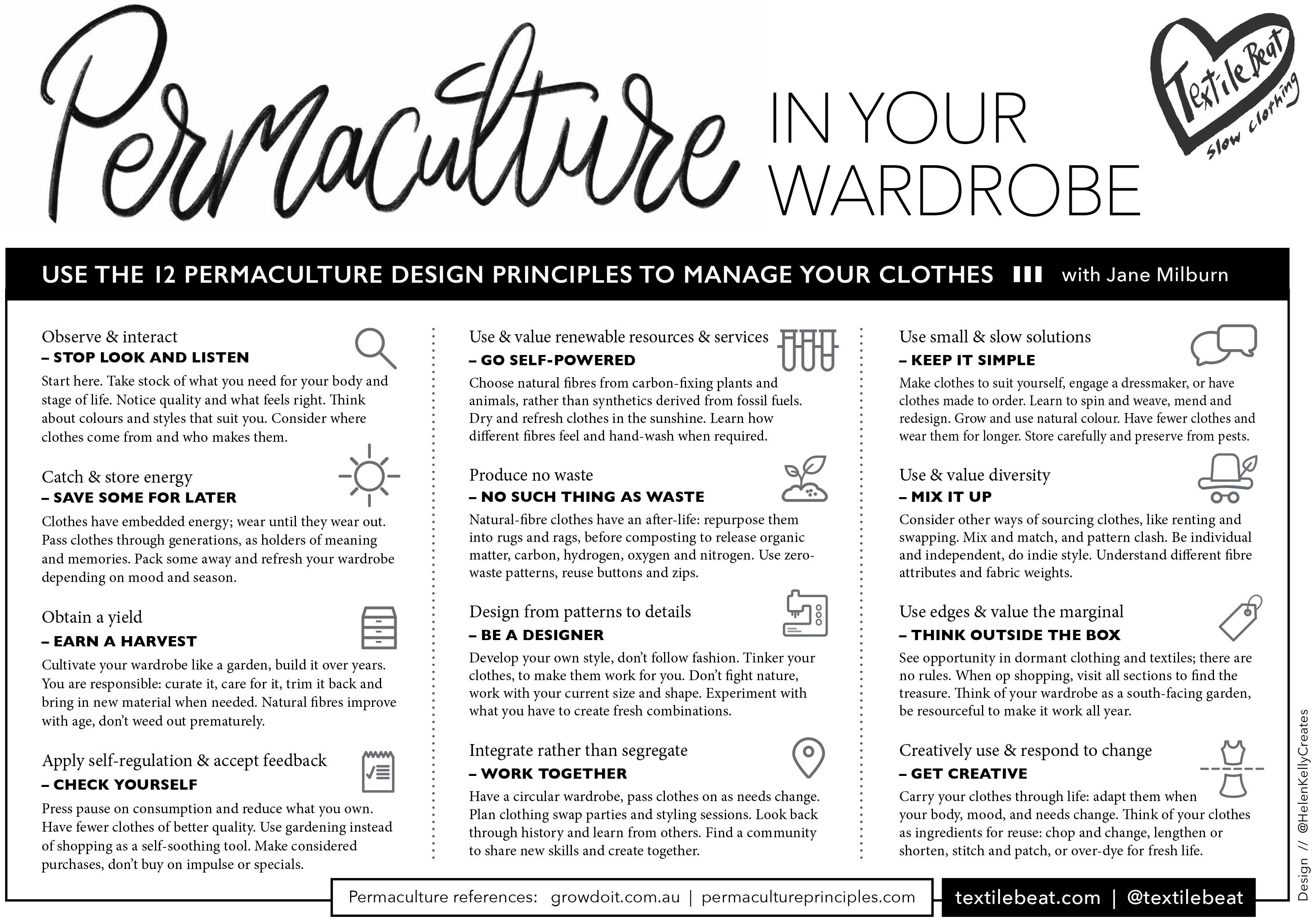For a decade I’ve been advocating for Slow Clothing philosophy as a response to fast fashion excess. Doing a Permaculture Design Course in 2020 and a Permaculture Teaching Course in 2021 led me to appeciate how Slow Clothing aligns with the permaculture ethics of people care, earth care and fair share and the 12 permaculture design principles can be applied to our wardrobe. Below is how my latest thinking on integrating Permaculture in your Wardrobe. I acknowledge input and inspo from David Holmgren permaculture principles and Grow Do It on the principles, and Professor Suzi Vaughan for helping with the thought process.

A permaculture framework for dressing with health and wellbeing, a Jane Milburn work in progress
Jane Milburn applies the 12 permaculture design principles to a regenerative wardrobe:
Observe and interact – stop look and listen
Start here. Take stock of what you need for your body and stage of life. Notice quality and what feels right. Think about colours and styles that suit you. Consider who grows the fibres and who makes the clothes.
Catch and store energy – save some for later
Clothes have embedded energy; wear until they wear out. Pass clothes through generations, as holders of meaning and memories. Pack some away and refresh your wardrobe depending on mood and season.
Obtain a yield – earn a harvest
Cultivate your wardrobe like a garden, build it over years. You are responsible: curate it, care for it, trim it back and bring in new material when needed. Natural fibres improve with age, don’t weed out prematurely.
Apply self-regulation and accept feedback – check yourself
Press pause on consumption and reduce what you own. Have fewer clothes of better quality. Use gardening instead of shopping as a self-soothing tool. Make considered purchases, don’t buy on impulse or specials.
Use and value renewable resources and services – go self-powered
Choose natural fibres from carbon-fixing plants and animals, rather than synthetics derived from fossil fuels. Dry and refresh clothes in the sunshine. Learn how different fibres feel and hand-wash when needed.
Produce no waste – no such thing as waste
Natural-fibre clothes have an after-life: repurpose them into rugs and rags, before composting to release organic matter, carbon, hydrogen, oxygen and nitrogen. Use zero-waste patterns, reuse buttons and zips.
Design from patterns to details – be a designer
Develop your own style, don’t follow fashion. Tinker your clothes, to make them work for you. Don’t fight nature, work with your current size and shape. Experiment with what you have to create fresh combinations.
Integrate rather than segregate – work together
Have a circular wardrobe, pass clothes on as needs change. Plan clothing swap parties and styling sessions. Look back through history and learn from others. Find a community to share new skills and create together.
Use small and slow solutions – keep it simple
Make clothes to suit yourself, engage a dressmaker, or have clothes made to order. Learn to spin and weave, mend and upcycle. Have fewer clothes and wear them for longer. Store carefully and preserve from pests.
Use and value diversity – mix it up
Consider other ways of sourcing clothes, like renting and swapping. Mix and match, and pattern clash. Be individual and independent, aka indie style. Understand different fibre attributes and fabric weights.
Use edges and value the marginal – think outside the box
See opportunity in dormant clothing and textiles; there are no rules. When op shopping, visit all sections to find the treasure. Think of your wardrobe as a south-facing garden, be resourceful to make it work all year.
Creatively use and respond to change – get creative
Carry your clothes through life: adapt them when your body, mood, and needs change. Think of your clothes as ingredients for reuse: chop and change, lengthen or shorten, stitch and patch, or over-dye for fresh life.